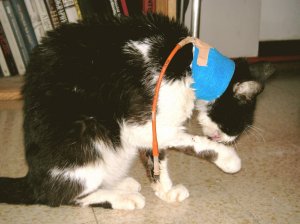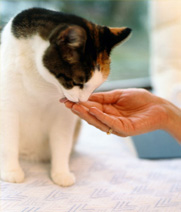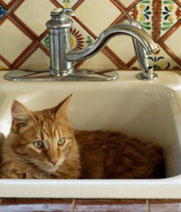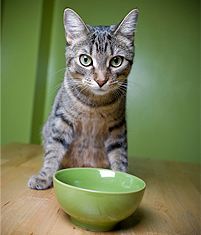From the Editors of The Daily Cat

 At 5 a.m., my cats want two things: breakfast and attention. Their Plan A is to meow louder than an alarm clock, which usually works. If I take longer than usual to respond, they resort to their no-fail Plan B: climbing on top of my head, butting my chin and purring with hypnotic desperation directly into my ear.
At 5 a.m., my cats want two things: breakfast and attention. Their Plan A is to meow louder than an alarm clock, which usually works. If I take longer than usual to respond, they resort to their no-fail Plan B: climbing on top of my head, butting my chin and purring with hypnotic desperation directly into my ear.
Perhaps you’ve also heard this special purr? Scientists have just named it “solicitation purring,” otherwise known as the purr we humans cannot ignore.
What Is Solicitation Purring?
Karen McComb, a cat owner herself, led the recent study on purring, published in the journal Current Biology. After she and her colleagues analyzed the acoustic structure of recorded cat purrs, they determined one particular type contains an embedded, high-pitched cry. “The high-frequency voiced cry occurs at a low level in cats’ normal purring, but we think that cats dramatically exaggerate it when it proves effective in generating a response from humans,” explains the University of Sussex behavioral ecologist.
The cry, much to a cat’s benefit, is very similar to that of a wailing human infant. “Cats have about the right size of vocal folds to produce a cry that is similar to a baby’s, so there is a coincidental element,” says Dr. McComb. In fact, she believes this cry component of a solicitation purr can sound remarkably like a crying child, and that is particularly effective with humans.
How It Works
If your cat sees you stirring from sleep at all in the early morning, it will immediately switch into giving this solicitation purring and position itself next to your head so you get the full impact. Sound familiar? Here’s what’s really taking place:
First Your cat gets a craving for food, water, attention, playtime or something else. Being relatively small, furry and unable to get to such things alone in your home, your pet sets a strategy in motion.
Second Your cat approaches you while vibrating its vocal folds, or cords, in its larynx. “This is not a normal vocal production mechanism [in the animal kingdom],” says Dr. McComb. “Usually in mammals, the vocal folds are just moved into the airstream and then are blown open and snap shut at their own natural frequency of vibration.” The resulting vibrating low fundamental frequency results in a purr.
Third Your cat doesn’t just continue to purr as usual. It voices a cry, “probably with the inner edges of the vocal folds,” believes Dr. McComb. The cry is superimposed on the regular purr.
Fourth You hear the solicitation purr and instinct kicks in. Studies show that most primates are driven to respond to the sound of an infant in distress, so your brain on some level perceives your cat as though it were an actual human baby, even though you consciously know it’s your needy feline.
Last If you are like most owners, you give in to what your cat desires. Considering cats cannot use actual words, the system is surprisingly effective. Nicolas Nicastro, who studied cat vocalizations at Cornell University, says that although they lack language, cats have become very skilled at managing humans to get what they want — food, shelter and a little human affection.
Have Cats Domesticated Humans?
Cats are domesticated animals that have learned to pull the right levers and make the right sounds to manage our emotions. And when we respond, we too are domesticated animals.
However, don’t confuse cats for little people. “Felines cannot say, ‘Take a can of food out of the cupboard, run the can opener and fill my bowl immediately,’” says Nicastro. They’ve evolved a different, yet no less effective, method of communicating with us.
Four Types of Purrs
Dr. McComb and Georgia Mason, a professor at the University of Guelph in Ontario, Canada, suggest cats might purr in at least four ways:
- Contentment purr This is “the relaxing one,” says Dr. Mason. It’s the common low frequency rumbling we both hear and feel.
- Silent purr Purrs can occur as silent forms that we humans feel but not hear. Kitten purrs are particularly easy to feel, probably because of a kitten’s ability to communicate “all is well” to its natural mother.
- Solicitation purr This is the newly identified purr with the embedded baby-like cry. “It’s amazing the way certain cries are recognized by humans as needy, even by non-cat owners,” says Dr. Mason.
- Pain purr Cats also sometimes purr when they’re extremely ill. No one is certain why, but some experts have speculated the felines are attempting to comfort themselves.
If you have heard the solicitation purr, consider yourself lucky. “Not all cats use this solicitation purring,” explains Dr. McComb. “It seems to most often develop in cats that have a one-on-one with their owners.”
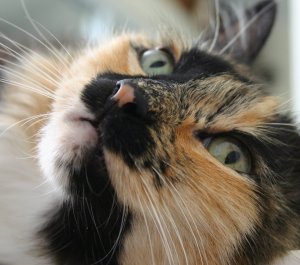 Hana didn’t need a contest to be a star. For 16-and-a-half years, this lovely girl brought happiness to her family. Unfortunately, time catches up with all of us, and on November 15, 2010, Hana crossed the Rainbow Bridge. A death in the family is always hard and you never really get over it. Meantime, it was nice to see how the OCR community appreciated Hana’s beauty and sweet soul. She won the contest — and our heart.
Hana didn’t need a contest to be a star. For 16-and-a-half years, this lovely girl brought happiness to her family. Unfortunately, time catches up with all of us, and on November 15, 2010, Hana crossed the Rainbow Bridge. A death in the family is always hard and you never really get over it. Meantime, it was nice to see how the OCR community appreciated Hana’s beauty and sweet soul. She won the contest — and our heart.
